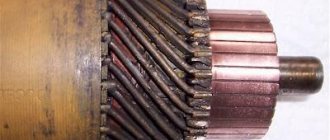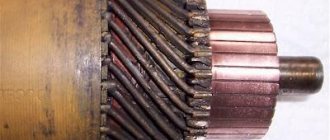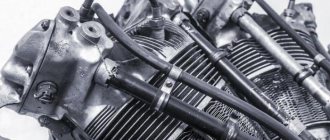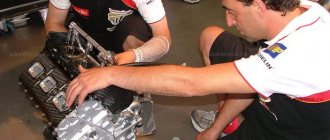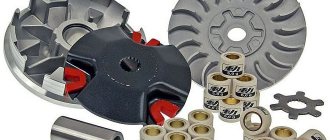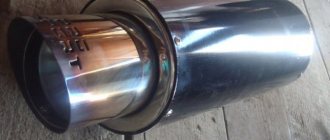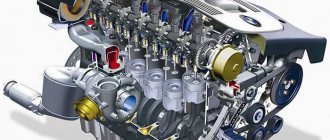How to get the most out of a scooter with tuning?
Scooter tuning is a fairly extensive process, but consists mainly of styling (improving appearance), chassis tuning (modifying driving characteristics) and engine tuning.
The last point consists of many different operations that are aimed at increasing engine power, its better implementation and increasing acceleration and maximum speed. Below we will consider modifications to the engine and transmission. It’s worth noting right away that the scheme is general and suitable for Italian, Japanese and Chinese models. Those who doubt the quality of Chinese scooters should be reminded that the level of production of modern models from the Middle Kingdom has increased significantly over the past 10 years, and most of the spare parts on the market for all models are from Chinese manufacturers.
There are many ways to speed up your scooter and, first of all, they depend on the current technical condition of the unit. Let's take, for example, an old scooter with an incorrectly configured variator, a clogged air filter, a dirty carburetor and a number of other problems that arise when the equipment is not properly maintained. Such an engine has great potential, but it can only be realized after proper tuning. After thorough cleaning and adjustment of all systems, even standard engine performance will seem like a significant improvement.
It follows that any work aimed at improving driving performance must begin with a complete revision of the engine.
Removing factory limiters is a very popular type of tuning and quite simple. Most of the Japanese equipment and similar Chinese equipment comes from the factory with special limiters that do not allow the engine to operate at full power. Fortunately, you can get rid of restrictions in any garage, and any tuning of a scooter with your own hands begins with the elimination of such restrictions.
When childhood illnesses are over, it is worth paying attention to real tuning, namely, improving or modifying existing components and assemblies. We are talking, of course, about the cylinder-piston group, carburetor, muffler, variator, air filter and ignition system
At this stage, the degree of involvement in improving a particular element depends on the budget. If funds are limited, then we will make the most of the existing set by modifying the described units.
If you have a certain budget for tuning, you can go the route of replacing parts with special tuning ones. Special parts designed for such modifications automatically improve the basic characteristics of the engine, plus they are designed for higher loads. We have figured out the general scheme of improvements, and below we will look at how tuning occurs, using examples of specific components.
Is it possible to avoid a fine?
It is not a fact that you will be able to avoid punishment, but you can try. First of all, the motorist must assume a guilty look and ask for the minimum penalty provided for by law (Articles 12.5 and 8.23 of the Administrative Code) - a warning. You can assure the inspector that the cause of the violation will be immediately eliminated, and the problem itself arose quite recently. It will be a plus if, when checking the fines, it turns out that the driver is not registered with them.
If the representative of the State Traffic Inspectorate is not influenced by any convictions, you can simply agree to the fine and pay it on time - then only 250 rubles will be collected from the driver in favor of the state.
Cleaning the cylinder, boring windows.
Improvement suitable for scooters with two-stroke engines. Their peculiarity is that very often the casting inside the drain and exhaust channels is defective, that is, it has roughness. These shortcomings lead to the fact that the piston is not blown through properly and, accordingly, loses power. Having removed the cylinder and armed with a rolling cutter, you can polish the channels, and then round off the sharp edges on the inside. When tuning scooters, in the photo you can see the differences between the motor before and after polishing. This action will help make the engine work easier at high speeds and potentially add a couple of kilometers to the top speed.
You can go further and increase the diameter of the inlet/outlet windows. For each 2T engine, this parameter is calculated individually. For example, it is enough to bore some 50 cc engines by 1 mm to obtain optimal intake/exhaust parameters. Do-it-yourself tuning of a 150cc scooter and other engine sizes is done in the same way.
Making a direct-flow muffler from scratch
You can make such a muffler from scratch. This will be a completely new version made from several components. The difficulty of this operation, called tuning from scratch, lies in finding the diagram of the exhaust system of a particular moped.
Tools and materials
In this case, again, you need to prepare the necessary tools and materials.
- Purchase in a store or find two pipes with a diameter of 33 mm;
- Buy plexiglass;
- Bolts M8 and M3;
- Prepare glue and nails;
- Welding machine;
- Needles;
- Hacksaw for metal.
Let's start assembling
First of all, you need to cut 18 cm from one of the pipes. It is recommended to carefully process the place in the cut with a needle file. From the second pipe we cut a circle with a diameter of 1.5 cm. We process it using the method described above. Glue the cut out circle in the section of the first pipe. We cut off another piece of pipe, 18 cm long. We make many holes in it. This can also be done with a sharp nail.
We connect all the parts using a welding machine. We fill the cavity formed at the junction of two pieces of pipe with mineral wool. We wrap the finished product with a special fire-resistant material. The homemade muffler is ready. To install it, you will need to attach the element to the scooter body mount.
Making a muffler mounting element
From plexiglass, which is indispensable in this matter due to its strength and easy paintability, we cut out a special type of ring, the edges of which can be bent outward by 180 degrees. We attach the resulting circles with serifs to the moped using the required bolts. We polish the muffler using sandpaper. To be sure, the joints between the homemade product and the moped body will need to be lubricated.
Homemade muffler for moped disassembled
If homemade production causes certain difficulties, you can find a lot of models of mufflers already in finished form. They are usually inexpensive. On the other hand, only a homemade version can provide the ideally expected option.
Element Benefits
What is forward flow? This element is a device that is an excellent alternative to a standard muffler.
It is often installed on motorcycles and scooters, but in some cases, passenger cars are also equipped with this part.
Essentially, a tuning direct-flow muffler changes the exhaust system, thereby significantly increasing engine power. Such devices cost quite a lot, so among motorcyclists the question of how to make a direct-flow muffler with your own hands arises very often. Below we will tell you how to make this element of the exhaust gas system yourself.
DIY saxophone muffler for scooter
Even with minimal tuning of the scooter, you need to think about installing a resonant exhaust .
The operating principle and review of saxophones, as such mufflers are popularly called, will be given in another article. A resonant saxophone muffler is not a cheap thing and not everyone can afford it. Accordingly, scooterists have a desire to save money and make such an exhaust pipe on their own. In this article you will learn how to make a primitive homemade saxophone using the example of a Yamaha Jog scooter. Why primitive? Because with this method we will not carry out calculations of the resonator (this requires a special program), but will simply use a drawing of a saxophone muffler.
Muffler conversion
As a rule, many craftsmen not only assemble a muffler, but remake a standard one. This makes it possible to spend less time and get a more acceptable option.
Tools and materials
Before you start tuning, you need to prepare the necessary tools. In this case, the following components will be needed:
- Welding machine, preferably with different operating modes;
- Pipe of appropriate size and diameter;
- Bulgarian;
- Several metal brushes for washing dishes.
Let's start tuning
First we dismantle the muffler. Then we take a grinder and cut out a piece of metal on top of the muffler. With this cut it will be much easier to work with the muffler. You should almost completely cut out the top part. After this, it is necessary to clean the entire internal space of the muffler, dismantling the cut-away elements.
It's time to work with the piece of pipe that we have prepared. Using a powerful drill or welding, we make many holes in the pipe. We place the pipe in the section of the standard muffler. We select in advance a pipe of such a diameter that it fits inside the standard one. It is desirable that the pipe be without any obvious flaws and perfectly straight.
Straight-through muffler in the process of assembly
The space in the cut that remains between the two pipes must be filled with metal pipe cleaners or similar materials. We weld the top of the pipe as it was. We reinstall all structural elements that were dismantled during the process.
As a result of the tuning, we will get a forward flow muffler that provides the desired result. The massive and rich roar of the engine, as well as the increase in power of the moped, will be evidence that everything was successful.
Tuning a muffler on a scooter - what will a saxophone give us?
The operating principle of the exhaust system on two-stroke and four-stroke scooters is radically different. Their task is the same, but otherwise they work differently.
The purpose of a muffler on a four-stroke scooter is to remove exhaust gases as quickly as possible with minimal noise. Therefore, tuning a muffler on a four-stroke bike is not at all a difficult task. Although, in both cases, it is necessary to change the pipes. In the case of a four-stroke engine, this is not so important in terms of which one to buy and whether anything needs to be configured. Everything is simple there.
But muffler for two-stroke engines are much more complex in production, settings and selection for each specific model for specific tasks.
The principle of operation of the exhaust system for two-stroke bikes is known and was discussed in the section “Scooter design”. It is known that part of the power is returned to the engine from the exhaust system during operation at certain speeds. If this whole process is implemented ideally, after tuning the muffler the scooter will be unrecognizable. Naturally, if other components were tuned before. After a general boost of the scooter, the stock muffler is not enough for adequate engine operation throughout the entire speed range and replacing the muffler with a tuning one is perhaps the only way to make your scooter run faster and more dynamically.
Tuning companies produce a huge number of wonderful mufflers for the most popular European, Japanese, Taiwanese and Korean scooters. You can always choose a specific model for any budget. The price in this case depends on the complexity of the design, quality, and popularity of the scooter model for which it is designed. However, it's worth it.
After installing a high-quality and correctly configured resonator on a two-stroke scooter, you can expect an increase in power of up to 25% only after professional adjustments to the power system. This is a considerable figure, considering that in tuning, for example, for racing, the struggle is for every millisecond during the competition
For everyday life this is not so important, and the difference in power increase between 20 and 25% is difficult to notice, but experienced scooter riders will not remain indifferent after installing a branded saxophone
All mufflers are divided into several classes and, depending on the class, its final cost is determined.
If you are not going to race and fine tuning is not your thing, you can look at cheaper pipes. Every self-respecting tuning company produces both budget pipes and premium exhaust systems
Don't pay attention to cheap saxophones made in China. The filling in these exhaust pipes does not meet the requirements of physics during engine operation, as a result of which, after replacing the stock pipe, you will not only throw away money, but also lose some power
What can we say if even on four-stroke scooters with a 139QMB engine, the Chinese manage to add a saxophone, which in this case is absolutely useless. Naturally, it is empty inside and there can be no talk of resonators, but there is no point in such a fashionable feature, and such a toy will only make professionals smile.
Source
DIY saxophone muffler for scooter
Even with minimal tuning of the scooter, you need to think about installing a resonant exhaust. The operating principle and review of saxophones, as such mufflers are popularly called, will be given in another article.
A resonant saxophone muffler is not a cheap thing and not everyone can afford it. Accordingly, scooterists have a desire to save money and make such an exhaust pipe on their own. In this article you will learn how to make a primitive homemade saxophone using the example of a Yamaha Jog scooter. Why primitive? Because with this method we will not carry out calculations of the resonator (this requires a special program), but will simply use a drawing of a saxophone muffler.
Cleaning the muffler
The cleanliness of the muffler affects the power of the moped
Before you start changing anything in the exhaust system, I would like to give one piece of advice. The power of the scooter is directly affected by the cleanliness of the muffler. If it were possible to see the exhaust in a cross-section of the muffler, the owner of the scooter would be very surprised. After a certain mileage, the scooter's dynamics decrease, and owners begin to look for the reasons for this, finding them in a complete rework of the standard muffler or its replacement.
The reason for the loss of power, meanwhile, may be hidden in the condition of the engine itself. This will help determine the specialist you should contact before tuning. But the most common cause of loss of dynamics is soot that clogs the muffler. In this case, it is recommended to carry out cleaning in three ways.
First method: mechanical
It involves cleaning the muffler section (it is done with a grinder). The inside of the muffler is cleaned of soot using a wire or cable. The section in the section is closed by welding.
Second method: chemical
It involves pouring water with some kind of cleaner into the muffler. For example, caustic soda is suitable for this purpose. This cleaning has the advantage that the appearance of the muffler will not be affected in any way.
Third method: heat treatment
The muffler is heated either on the scooter with a blowtorch, or dismantled in an oven or on a grill. It will be necessary to repaint the muffler only after it has cooled.
Why is there a penalty for making a loud muffler?
In the paper “Basic provisions for the approval of a vehicle for operation” there is clause 6.5, which states GOST R 52231-2004, that is, it specifies the standards for the external noise level, and anything higher will already be considered a violation. It contains table No. 1, which states what level of noise in decibels can be emitted by the engine exhaust system of a car that is used for movement (we will attach it in the section below).
In addition, in the same document there is paragraph 9.10 of TRTS 018/2011, which mentions that it is strictly forbidden to change anything in the mechanism of the exhaust gas exhaust system. Therefore, if the noise threshold is even slightly higher than the required standard or alterations have been made to the exhaust system, then this is a violation of the law.
Why do you need quality mufflers?
As you know, a certain amount of fuel combustion products accumulates in the cylinders of a moped engine. They must be thrown out and in this case it is the muffler that is responsible for this. In other words, this unit seems to smooth out the pulsations that are inevitable when combustion products are released at high speed.
The very design of the muffler, used not only on scooters and mopeds, but also on motorcycles and cars, implies a special exhaust system, which can be different, depending on what result the vehicle owner wants to achieve. For example, if the desire to improve the gas exhaust system is related to increasing the power of the scooter, a special type of muffler is required - a direct-flow muffler.
Direct flow type muffler
Direct-flow muffler device for moped
Installing this type of muffler will not only increase dynamic power, but will also significantly increase the noise emitted when gases escape
On the one hand, this is good, because this way you can attract the attention of other drivers, thereby increasing passive safety. As you know, drivers of large cars often complain that they do not notice motorcyclists, and mopeds and scooters even more so
Making such a muffler from scratch or using a method that involves tuning is not difficult, but many technical aspects need to be studied.
Features of a direct-flow muffler
The features of direct flow are as follows: exhaust gases are ejected outside the engine immediately, the cylinders of the power unit have time to fill with the fuel mixture in the optimal amount.
I would like to remind all readers that at the moments of intake and exhaust, engine valves tend to open and close. Between these stages, a vacuum occurs, which allows the cylinders to be cleared of exhaust gases. As a result, free space is freed up, where the fuel mixture is supplied. It is easy to guess that the faster the cylinders are released from exhaustion, the faster they will be filled.
Thus, if you can ensure a faster exit of gases from the system, the performance and, as a result, the power of the scooter or moped will increase.
Muffler for moped: types, features and tuning
What is a muffler and what is it used for? The goal is to acquaint you not only with how to construct a homemade muffler for a scooter with your own hands, but also with the purpose of this important unit.
Two stroke and four stroke scooter
A scooter, as you know, can be with a two-stroke or a four-stroke engine. The operating principle of the entire exhaust system differs radically among analogues.
The muffler on a four-stroke scooter removes gases in a relatively shorter time, doing this with minimal noise. In addition, tuning the muffler in this case will be quite simple. On the other hand, in both cases, when carrying out tuning, it will be necessary to change the pipes.
Types of mufflers for scooters
For the muffler of a two-stroke scooter, selecting components that make it possible to carry out tuning will be much more difficult. The standard muffler itself for such scooters is more difficult to manufacture and configure.
The exhaust system of a two-stroke scooter works as follows. During the process of cleaning exhaust gases, part of the power is returned to the engine. This happens at certain speeds and if you manage to implement this whole process by tuning, the scooter will be unrecognizable.
You can install a high-quality and correctly tuned resonator on a two-stroke scooter. This will give a noticeable increase in dynamics up to a quarter. But in this case, it will be important to carry out professional settings of the entire power system.
Why do you need quality mufflers?
As you know, a certain amount of fuel combustion products accumulates in the cylinders of a moped engine. They must be thrown out and in this case it is the muffler that is responsible for this. In other words, this unit seems to smooth out the pulsations that are inevitable when combustion products are released at high speed.
The very design of the muffler, used not only on scooters and mopeds, but also on motorcycles and cars, implies a special exhaust system, which can be different, depending on what result the vehicle owner wants to achieve. For example, if the desire to improve the gas exhaust system is related to increasing the power of the scooter, a special type of muffler is required - a direct-flow muffler.
Direct flow type muffler
Direct-flow muffler device for moped
Installing this type of muffler will not only increase dynamic power, but will also significantly increase the noise emitted when gases escape. On the one hand, this is good, because this way you can attract the attention of other drivers, thereby increasing passive safety. As you know, drivers of large cars often complain that they do not notice motorcyclists, and mopeds and scooters even more so.
How to Make a Yamaha Jog Saxophone Silencer
So let's get started. To make a saxophone, we need metal approximately 1.2 mm thick. It must be cut according to the dimensions indicated on the drawing (You can adjust these dimensions closer to your parameters). In order to accurately bend the metal, we grind a wooden blank to size (we get a kind of wooden muffler) and then bend the steel according to this shape. After carefully adjusting the workpiece, we weld the joints using semi-automatic welding. We clean the part using any available means.
We also bend the muffler and muffler pipe. On one side we weld it completely, and on the other side with rivets (to replace the filler, here it is glass wool). After welding, we check all elements for leaks - there should be no gaps, of course.
We sand all the parts and paint. In this case, the muffler is painted with powder paint, and everything else is painted with simple acrylic paint.
The fastenings on the muffler are made of stainless steel.
And here is the result of our painstaking work - a copy of the Tecnigas saxophone. Not bad, right?
A saxophone on a scooter looks even better.
After installing such a muffler, you may need to adjust the scooter's carburetor, adjust the transmission as a whole, and the engine in general.
Good evening everyone, blog readers... Today there will be an interesting entry, but first of all it will be of interest to those who have mopeds and light motorcycles... Now I will tell you how, without any collective farm work and sawing the muffler and similar things, you can make a pleasant exhaust and a sound that you will like even with Every turn of the throttle, the sound will amaze you more and more... I read a bunch of articles and everything about this, I also watched a bunch of videos of how they cut off the original muffler, drill holes in it, and so on... In short, I am an opponent of such tuning, it’s just stupid... By Therefore, we decided to come up with and create a structure ourselves that will not only be installed, but can be removed... And so, if you are ready, let's begin...
One day I turned to my friend Zelencoff to come up with something to change the exhaust sound to a more pleasant one... I’m just the kind of person who loves a pleasant exhaust sound, I can listen to it for hours. For example, on my car I have a home-made muffler from a GAZelle, completely overcooked and redone as it should, and stuffed with cotton wool that doesn’t burn too tightly... And the result is a pleasant sound, like it’s not a direct flow and there’s not a lot of bass, but it’s pleasant to listen to and doesn’t put pressure on the ears. By the way, it’s also like Ruslan’s idea. So... I got distracted, let's return to our sheep... Phew. to motorcycles. In general, they tried on a bunch of all sorts of pipes, all sorts of cans and bottles and came up with who knows what. then we look at an empty paint can lying around, we sawed off the neck and bottom and just brought it to the muffler and this is what happened...
After that, we began to think about how to create this entire structure, secure it and make it completely removable... At this point my head turned on, I thought about how this could be done and explained to Ruslan how we would do it. And off we go... now everything will be described in detail.
What is a muffler and what is it used for? The goal is to acquaint you not only with how to construct a homemade muffler for a scooter with your own hands, but also with the purpose of this important unit
Resonant exhaust and its types
What is a resonator, a half-wave trumpet, a saxophone for a scooter, how it works and why it only works on a 2T motor, see this video.
Zhen give me some advice, Scooter Suzuki Address v100 CE13A engine with a catalyst, I drove more than 20 thousand, I started catching sticks at a speed of 75 when driving together, even at an outside air temperature of less than 20 degrees, they said the oil pump drive needs to be checked while adding oil to the gasoline, I calculated that at 600 km the oil tank leaves 350 ml... I add another 50 ml to 5 liters and still gets stuck... Where to look? Can a muffler cause problems? There is compression, it drives as before, the maximum speed is 90 - 95 km (as usual, nothing has changed (belt, variable speed gear are ok)
where can I get a normal muffler for a yamaha jog? and how much does it cost?
in short, I realized that it makes sense to install resonators for road motorcycles that ride at a certain engine speed
what if you put it in the first place? how will it work?
Basically, all lectures about resonators create the impression that a person has heard something about resonance, repeats ready-made terms as a fact, with a confident look, but still does not fully understand the physics of the process. After all, simple questions, but, I assume, lecturers answer them will not be able to answer: “The sound wave that is visible during an explosion,” which the lecturer talks about, is, firstly, not a sound wave, but a supersonic wave. Only such a wave is visible. Does a supersonic wave have a frequency (like a sound wave), and what is that frequency? What frequency should the resonator be tuned to? Is this the frequency of the sound wave that occurs when the working mixture explodes? Or is it the crankshaft speed? Or even some frequency or length of a supersonic wave? Does the waveform matter (U-shaped, sawtooth, sine)? Are the formulas for calculating acoustic systems and bass reflexes applicable to calculating the resonator of an internal combustion engine? After all, sound waves appear there, and supersonic ones here? And if you bring your hand to the exhaust pipe, then there is no sound wave at all, but there are some infrasonic vibrations of the air. Maybe they are talking about them, creating pressure and vacuum at the right moments? Thus, we have at least 3 types of waves in the exhaust system: supersonic, sonic and infrasonic, and modulation, the superposition of one on top of the other. Which of them do we design the system for? And there are also standing waves, such a thing as a waveguide pipe and many other things. None of this is covered here. Once you dig deeper, an understandable, coherent lecture turns into “nothing is clear.”
Do these principles apply to cars? Why do they usually say that the resonator makes the exhaust quieter, but here, on the contrary, it turns out to be louder? Conflicting information. They call it a “pre-muffler” there, but here they call it a saxophone (sound enhancer)? Glass wool is shoved into a car resonator, but here it is contraindicated; on the contrary, the fewer unnecessary impurities and the purer the metal, the better.
What is the difference between saxophones that give a boost at low revs and those with high revs? and how do they differ externally in terms of cones or maybe some nuances? I need it to start working at 5000 rpm because the engine from the Grand is low-speed
We remove the engine.
Specialists, experts or garage technicians begin tuning a scooter with their own hands by dismantling the factory limiters. They are necessary to, firstly, keep the equipment within the established speed limits (Japanese models), and also to increase the service life of the motor. The problem is that you can find this element only after studying your engine model on various forums. The reason for this is the different locations of these same limiters, it could be a blind fork in the exhaust, an electronic limiter installed on the variator or even in the carburetor.
- Plug in the variator. In this case, the part is a special plate mounted on the side of the weights. It prevents the belt from reaching its maximum radius, which means it is impossible to achieve the maximum possible speed. If you have such a part, then by removing it you can significantly increase the maximum speed.
- Limiter in the variator. Sometimes the limiter is the lip on the bushing itself; here you cannot do without the work of a turner. By loosening the limiting edge of the variator, you can increase the speed. Also for many models a ready-made, bored part is sold.
- Carburetor. In this assembly, the plug looks like a valve. With a significant increase in pressure, it opens, thereby preventing the full entry of the air-fuel mixture into the combustion chamber. This can all be treated as in previous options - by dismantling the element or replacing the entire part.
- Exhaust. An interesting restriction system is located in the exhaust. It represents a branch where one of the channels is a dead end. Thus, turbulence and internal pressure in the exhaust increase, which prevents high-quality purging of the combustion chamber. The problem can be solved by brewing dead-end branches.
- Electronic system. Finally, the switch limiter can be considered the most advanced by modern standards. Some Chinese and Italian models can be deceived by cutting the limiter wire, for this you will have to study a lot of literature on electrical engineering. Other models get rid of the problem by simply replacing the unit.
The working principle of a resonant muffler or saxophone
The principle of operation of the muffler
As soon as the piston moves down and opens the exhaust port, a wave of exhaust gases in the resonator, racing at the speed of sound, sets off a sequence of events that lead to an increase in engine power and torque.
Positive pressure wave As soon as the mixture in the cylinder begins to burn, the piston moves down and opens the exhaust port. Exhaust gases under pressure fly out into the exhaust pipe at great speed, creating a wave of positive pressure.
The time interval between the opening of the exhaust and intake channels is called the exhaust lead. The exhaust stroke allows high-pressure and very hot exhaust gases to escape into the resonator and thus create a vacuum in the combustion chamber, due to which a new portion of the combustible mixture is sucked in. If this does not happen, the exhaust gases may be sucked back into the cylinder and there will lead to an uncontrolled combustion of the air-fuel mixture.
Negative pressure wave Exhaust gases escaping at great speed have great inertia, due to which they create a strong negative pressure in the combustion chamber (approximately -7psi) near the opening intake channel. A new portion of the air-fuel mixture is sucked into the combustion chamber by this negative pressure. But, since the exhaust channel remains open for some time at the same time as the intake channel, part of the fresh combustible mixture inevitably flies out into the exhaust pipe.
Positive pressure wave The exhaust gases emitted into the muffler quickly expand in the first cone, pass through the resonator and hit the sharply narrowing opposite cone, which prevents them from immediately flying out. Some of the gases return back to the exhaust channel of the cylinder, thus stopping further formation of vacuum in the combustion chamber.
Pressurization through the exhaust port And finally, as soon as the piston closes the intake channel, the pressure created by the exhaust gases remaining in the resonator forces the escaped part of the fresh air-fuel mixture to return to the combustion chamber. Thus, at the moment of ignition, there is significantly more combustible mixture in the cylinder under high pressure, which leads to an increase in engine power.
Example of a resonant muffler
Resonant muffler design
But simply welding and screwing the resonator to the engine is not enough to increase its power. In this matter, everything plays a role - the volume of the pipe, the size of the resonator cones, and the size of the muffler. Fortunately, all these factors are taken into account by manufacturers when developing exhaust systems.
- Smoothly tapering resonator cones increase torque and power, but do not improve overall engine performance.
- Steeper resonator cone angles increase intensity but shorten the time it takes for the positive and negative pressure waves to travel through the exhaust port. These exhaust pipes can significantly increase engine power and torque, but only within a very narrow rpm range. In addition, the power becomes dependent on operating conditions and weather conditions: an increase in temperature or air humidity will negatively affect the operation of the resonator.
- The faster you ride your scooter, the shorter the tube should be, and vice versa.
- Low quality gasoline greatly affects the operation of the resonant muffler, changing the temperature of the exhaust gases, and, as a result, their pressure and speed.
© 2021 Alexander Smirnov, gilerarunner.ru. Spare parts and accessories for Italian motorcycles from Europe. Phone/WhatsApp or email The email address is protected from spambots. Javascript must be enabled in your browser to view the address.
Posts 1 page 30 of 67
Share22012-02-10 16:14:17
So much I want to say and so little time! It all started, as you already understood, with the modification of the manifold to an increased diameter of the pipe for better exhaust gases and reduced flow resistance. It was logical to continue the refinement and make a direct-flow muffler. Which is actually what I did the other day! Something like inspiration came to me. At first I began to develop the future concept in my head, but how often does it change during the work process! I wanted to find a seamless pipe without seams (this was the first snag). There weren’t many options until I saw an ordinary fire extinguisher at work. And then an idea appeared and began to develop rapidly in my head! Since the total length of the muffler, according to my calculations, should be at least 400 mm, and fire extinguishers with such a length are too thick, it was decided to take two small ones and make a completely assembled (dismountable) muffler. As I already said, two old unnecessary fire extinguishers were taken, the powder was released and the valves were unscrewed. Then they cut off the back parts. It looks like this:
What’s most interesting is that the muffler ITSELF will look like this:
Then you need to somehow make the ends on the muffler; for this, 6mm thick sheet metal was taken and two pancakes were cut out, which were then turned into flanges! Why such large holes, you ask? So that later you can safely insert tubes of DIFFERENT DIAMETERS. on both sides and fill with refractory material. The flanges will be tightly welded.
Pipes of different diameters will be inserted into these two jars! Why is this done, you ask? I want to achieve only low frequencies and get rid of high frequencies. A pipe with a diameter of 70mm will be installed at the outlet, and a pipe with a diameter of 40mm will be installed at the inlet to the muffler. The joint in the form of a narrow transition in the middle will cause a curvature of the flow of passing gases! The holes in the tubes will also be of different diameters. That's all for today.
We adjust valves (4t engines).
As mentioned earlier, the engine must be serviced before boosting. Work that will help improve dynamics includes adjusting the valves. The procedure is suitable for tuning Chinese 4t scooters and other 4-stroke engines. For small-capacity equipment, it is recommended to carry out such adjustments at least once every 3, and preferably once every 2 thousand km. It is also necessary to carry out adjustments after manipulations with the CPG.
Before you begin, you need to make sure that the engine has completely cooled down and that you have a set of keys (8,9) and feelers of 0.05 for the intake valve and 0.07 mm for the exhaust valve at hand. You can get to the adjusting nuts by first removing the valve cover. When access to the valves opens, the piston is installed at top dead center. Next, a feeler gauge is installed in the intake valve gap and, depending on the current position, an adjustment is made.
To increase or decrease the clearance, you need to loosen the lock nut (while holding the adjusting bolt), turn the adjustment bolt and, while holding it, tighten the lock nut back. Thus, we achieve a gap when the probe passes into it with little effort. After adjustment, make a full revolution of the crankshaft and make sure that the adjustment is accurate.
Are there any advantages to direct flow?
Why are some motorcyclists desperate to turn up the volume on their steed? Their classic argument: “Loud exhaust saves lives.” This argument works in occasional situations that are typical on our roads, but there is no scientific evidence of the benefits of loud exhaust in avoiding accidents.
Moreover, this argument presupposes the correct behavior of road users when they hear a motorcycle roar. But this is an extremely risky assumption: the driver may be frightened by a loud roar next to him and behave completely differently from what is expected of him, which can be dangerous for the motorcyclist. A loud exhaust may be noticeable, but it is unlikely to be a more effective means of preventing accidents than safe driving skills coupled with reflective elements on equipment and a mandatory helmet on the head.
Even if the "loud exhaust saves lives" argument works in some situations, it doesn't do enough to compensate for the unpleasantness of it. To be honest, many motorcyclists use forward flow to attract attention and show off their own “coolness”, without caring about their safety or those around them.
This justification for using direct flow is too selfish, don’t you think? On one side of the scale is the joy of motorcyclists, on the other is the peace of those around
Which of these is most important?
Does the inspector have the right to fine under 2 articles?
No, the traffic police representative does not have such a right. Part 2 of Article 4.4 of the Code of Administrative Offenses clearly makes it clear that if the driver’s actions can be regulated by several articles of the Code, punishment can be imposed only under one of them, which provides for the most severe measures. You can learn more about “Can an inspector issue several fines” from this article.
In this case, the penalties for both articles – 12.5.1 and 8.23 – will be similar and the fine will be 500 rubles.
All homemade products
If you have an old but indestructible Japanese scooter, which, unlike the rotten Chinese, does not shine with chrome, but no one deserves to look beautiful and dignified. Therefore, let's give the muffler a new look.
We really need simple materials:
- A small sheet of thin stainless steel, 0.4-1 mm thick.
- A piece of roll of heat-resistant thickness, sound insulation ~5 mm (asbestos or other)
Tools:
- Welding grinder.
- semi-automatic with a thin disk of 1 mm.
Lyrical digression.
Over time, even with the most famous manufacturers of motorcycles, in my case it is Honda, the muffler becomes completely clogged with exhaust carbon, after which the engine completely stops starting and we are left with only two options, buy a new Chinese one or disassemble the muffler and clean the old one.
But Chinese mufflers in most cases are just a thin and empty can, in which there is absolutely no reverse wave resonance system, and for a two-stroke engine this is a sentence for a loss of power of up to 50% and, like a scooter, the result completely stops driving!
Therefore, a recommendation to everyone is to choose the second option - cleaning, and not if, well, replace it with the Original!
When sawing the muffler can for cleaning, out of hopelessness, it is necessary to remove the internal fiberglass noise insulator of the body, after which the sound of this working scooter becomes more disgusting and loud (ringing), the can of the body resonates, and the appearance of the muffler also suffers and is no longer as neat as before.
Therefore, this tuning kills two birds with one stone, a decorative muffler decoration and additional noise insulation, which completely returns the noise level to the new norm.
Manufacturing and Unscrewing.
assembly four nuts and remove the muffler.
length We measure the circumference of the muffler and its length by welding between the seams.
To the resulting dimensions of the circle for 2-3 cm we add the joint, and to the width we add 2 cm for the bends. We cut out a calculated rectangle from thin stainless steel.
On the wide sides we make bends of 5 - 6 mm. It is enough to place it on the corner, fix it with two clamps and tap it with a hammer.
Polish the surface immediately, for example with GOE paste.
1mm Thin. Using a disk, we make cuts along the entire height of the bend, in increments of 5 mm.
We remove the sharp edges and get the result.
According to the dimensions of the hangnail, we cut out a piece of noise insulator (eg asbestos, weave, fiberglass, etc.) so that it fits tightly inside between the bends and is equal in length to the circumference of the muffler can.
We wrap the “This” sandwich around the muffler can so that the joint is inward towards the wheel.
convenience For convenience, we compress and secure other clamps or fasteners (for example, rubber rings, belts).
spot We perform welding.
We remove the fasteners and install the muffler back on the scooter.
Let's start it!, enjoy how it runs quietly and admire the shine of the new silencer!
Scooter exhaust system - design features and operating principle
Often owners of scooters, especially two-stroke scooters, underestimate the impact of a properly functioning and properly tuned exhaust system on the performance of the scooter, from idle to maximum power and torque, maximum speed and dynamics.
An exhaust system refers to a systematic approach to removing exhaust gases from a scooter engine to the outside. The exhaust system also serves as a muffler for the noise generated during each combustion cycle, and the noise must be absorbed to specified levels so as not to disturb other drivers and passers-by.
During the operation of a scooter engine, the exhaust gases that exit the cylinder are under fairly high pressure and are released at enormous speed. The loud noise of an engine without a muffler is characterized by the fact that it is the effects of pressure and velocity of exhaust gases that create the conditions for their expansion in the air. Therefore, mufflers for scooters, as well as for other equipment, are created in such a way that gases enter the atmosphere after the most effective cooling and pressure reduction. However, this is only a small part of the design features of the exhaust system.
Exhaust system and muffler of a four-stroke scooter.
A properly configured scooter exhaust system is the key to stable engine operation with maximum efficiency. This also applies to four-stroke engines. The four-stroke design provides for controlling the flow of the fuel-air mixture and exhaust gases using valves. A properly designed exhaust system for a four-stroke scooter should provide pressure in the muffler in such a way that at the moment of the exhaust stroke it creates a small vacuum in the exhaust valve area, which, without adjustment, will, one way or another, arise in another area. The engineers' task is to shift this vacuum zone precisely to the exhaust valve.
Source
Saxophone muffler on a scooter - operating principle and technical features
Buying a muffler
Here we have already examined in detail the feasibility of such a purchase when tuning a two-stroke scooter, analyzed the “saxophone” market and selected the most popular resonator models today, from the budget segment to racing options.
So, it is already clear that a “saxophone” cannot be bought just like that. This should be facilitated by a series of calculations and selection of the most suitable model, based on engine size, engine model, additional modifications, presented tasks and the budget that will be allocated for general tuning. It is worth repeating that cheap resonators do not exist in nature. Even budget pipes cost more than $100, let alone options for more serious tuning.
Chinese resonators
Equally important, the Chinese “saxophone” exhaust pipe is almost always just a product made of thin metal, very similar in appearance, but essentially has nothing in common with resonators. When designing, neither the volume of the pipe nor the size of the resonator cones are taken into account; the main thing is the appearance.
You just have to remember the use of such parts on four-stroke engines (this also happens) from the factory and it becomes clear that this is just a marketing ploy, nothing more.
The principle of operation of the “saxophone” muffler on a scooter
The operation of a properly selected resonator resembles the process of a turbine, when the compression of the mixture inside the cylinder increases. The operating principle of a two-stroke engine determines the loss of part of the fuel-air mixture during the intake-compression stroke, when it simply flies out into the pipe. The task of the resonator is to create the required pressure in the pipe, thereby containing part of the exhaust gases as efficiently as possible. This does not allow the fuel-air mixture to freely exit the exhaust channel, as a result of which the filling of the combustion chamber increases, the pressure in the combustion chamber increases, and hence the engine power.
During the downward movement of the piston, when the exhaust port opens, a series of events occur in the resonator that determine the subsequent increase in engine torque and power. Immediately after the mixture ignites in a two-stroke engine, the piston moves down and opens the exhaust port of the cylinder. Naturally, the exhaust gases rush into the exhaust pipe at great speed, creating a certain wave of positive pressure there. This process is shown in Fig. 1.
The time interval between the moments of opening the exhaust and intake channels in this case should be called the term “exhaust stroke”. Essentially, the exhaust stroke allows hot, pressurized exhaust gases to escape into the resonator. At this moment, a vacuum is created in the combustion chamber, after which a fresh portion of the fuel-air mixture is sucked into the cylinder and, in fact, ignites. Without this, it is difficult to avoid controlled combustion.
This is followed by a wave of negative pressure (Fig. 2). The essence of this process is that a strong negative pressure is created in the combustion chamber near the opening intake channel. This happens due to the fact that gases escaping at great speed have great inertia. During a wave of negative pressure, a fresh portion of the mixture is sucked into the combustion chamber and immediately part of it flies out into the exhaust pipe due to the fact that the exhaust and intake channels remain open at the same time for a short period of time. This is the structure of a two-stroke engine.
This is followed by another wave of positive pressure (Fig. 3), when the gases emitted into the exhaust pipe, expanding in the first cone, tend further and, passing through the resonator, hit the opposite cone, which sharply narrows, thereby preventing the exhaust gases from escaping immediately or go outside. At this moment, part of the gases returns back to the exhaust channel of the cylinder, after which further vacuum formation in the engine combustion chamber stops.
How to make forward flow on a scooter
You will need
- – Bulgarian;
- – drill;
- - hammer;
- – mesh or tube with holes;
- - fiberglass;
- – heat-resistant paint.
Instructions
First, remove the decorative protective plates and muffler by unscrewing the four bolts. Cut it from the end in a circle using a grinder or a hacksaw. Now you need to find and drill out the welding points with a drill, using first a thin and then a larger diameter drill. Knock out the back wall with a hammer and remove the perforated mesh that is located in the front.
Leave the housing from the old muffler. Make a central tube from a tube or mesh with a large number of holes. Holes in the pipe can be made using a drilling machine. Use fiberglass as padding. First you need to fasten all parts of the muffler with several welding points. If everything works fine when you start it, do a major repair.
Make a mesh clamp using the appropriate size pipe. Weld the clamp and insert the mesh inside. On the other hand, the mesh is fixed by a tube, which is also the outlet. Pack the fiberglass very tightly between the body and the mesh to prevent the insides of the muffler from flying out over time. Wrap the tube itself with asbestos or any other fire-resistant material.
Having finally assembled the muffler, clean it, degrease it and paint it with special paint. It is advisable to seal the muffler connection points with sealant.
Video on the topic
https://youtube.com/watch?v=ob5fOdCc3Dk
note
You need to cut the muffler very carefully so as not to damage the partition and the tubes that are inside. When sawing, be sure to use special glasses to avoid damaging your eyes.
Helpful advice
Instead of fiberglass, the padding can be made from kaolin wool. It does not burn or melt even at a temperature of 1300 degrees. The exhaust sound depends on the packing material, the diameter of the perforated tube, and the length of the muffler.
- Do-it-yourself forward flow on a scooter in 2018
- how to make forward flow on a moped in 2018
Cylinder-piston group.
Finally, the most effective improvement for any engine is replacing the CPG. But not just a replacement, but the installation of a new, larger piston. Fortunately, there are now many ready-made kits on the market; you don’t have to sharpen or adjust anything, as with Soviet equipment. Moreover, there is even a lot to choose from. For example, for various models with a volume of 50 cubic meters, they offer kits to increase to 63, 72, 82 and even 90+ cubic cm. In some cases, this is an almost double increase in power.
The situation is similar with larger engines, for example, for 125 cubic meters, sets of 150 or 170 cubic meters are sold. Some, in the process of tuning a scooter, manage to increase 150 cubic meters with their own hands to 225 cubic meters. Choosing the right part is not the most difficult thing, the most difficult thing is installing it. After all, this process involves almost complete disassembly of the engine. You will be faced with the need to have several special removable keys in your arsenal; you can ask them from friends or borrow them for the evening at auto repair shops. We strongly recommend studying the technical component in order to properly disassemble, replace the necessary elements and assemble the motor.
Alas, for some, increased power does not promise anything other than breakdowns or inadequate performance. This is because by significantly increasing power, you inevitably entail work on all other nodes. Let's imagine that we installed a new 92 cc CPG on an old 50 cc engine. The first thing to check is the condition of the connecting rod, crankshaft and bearings. Otherwise, they will fly first, followed by our new system of both cylinder and piston.
Great, we added new bearings to the CPG, an elbow with a connecting rod, now we can be sure of reliability. But the engine does not go faster, and we decide to purchase a new carburetor. Now the mixture is too rich, and we understand that the exhaust needs to be changed. After such modifications, the engine sounds loud, accelerates perfectly, but the maximum speed is slightly higher than before and the variator sounds strange. After installing a high-speed CVT, for example from the Italian manufacturer Polini, the engine will be able to fully realize its new power. The last stage is an inspection of the brake system; you don’t want to find out at a speed of 60 km/h that the brakes are now comparable to bicycle ones.
As a result, after replacing almost all the components, we got a very fast “flea” that can surprise your friends and experts in this technology. Over time, you can make changes to the chassis system, replace shock absorbers, and install more attractive wheels. Often, the modernization process does not stop there, and after tuning a scooter 50, 150 with your own hands, impressive improvements in appearance are made. The moped is repainted, panels are changed, new devices, lighting, and so on appear.
DIRECTORY
The resonator, due to its conical shape, holds back part of the exhaust gases, creating pressure in the exhaust pipe, which prevents the fuel mixture from leaving the exhaust channel and thus increases the filling of the combustion chamber and the pressure in it.
How it works?
As soon as the piston moves down and opens the exhaust port, a wave of exhaust gases in the resonator, racing at the speed of sound, sets off a sequence of events that lead to an increase in engine power and torque.
Positive pressure wave As soon as the mixture in the cylinder begins to burn, the piston moves down and opens the exhaust port. Exhaust gases under pressure fly out into the exhaust pipe at great speed, creating a wave of positive pressure.
The time interval between the opening of the exhaust and intake channels is called the “exhaust lead”. The exhaust stroke allows high-pressure and very hot exhaust gases to escape into the resonator and thus create a vacuum in the combustion chamber, due to which a new portion of the combustible mixture is sucked in. If this does not happen, the exhaust gases may be sucked back into the cylinder and there will lead to an uncontrolled combustion of the air-fuel mixture.
Negative pressure wave Exhaust gases escaping at great speed have great inertia, due to which they create a strong negative pressure in the combustion chamber (approximately -7psi) near the opening intake channel. A new portion of the air-fuel mixture is sucked into the combustion chamber by this negative pressure. But, since the exhaust channel remains open for some time at the same time as the intake channel, part of the fresh combustible mixture inevitably flies out into the exhaust pipe.
Positive pressure wave The exhaust gases emitted into the muffler quickly expand in the first cone, pass through the resonator and hit the sharply narrowing opposite cone, which prevents them from immediately flying out. Some of the gases return back to the exhaust channel of the cylinder, thus stopping further formation of vacuum in the combustion chamber.
Pressurization through the exhaust port And finally, as soon as the piston closes the intake channel, the pressure created by the exhaust gases remaining in the resonator forces the escaped part of the fresh air-fuel mixture to return to the combustion chamber. Thus, at the moment of ignition, there is significantly more combustible mixture in the cylinder under high pressure, which leads to an increase in engine power.
Example of a resonant muffler
Exhaust system design
But simply welding and screwing the resonator to the engine is not enough to increase its power. In this matter, everything plays a role - the volume of the pipe, the size of the resonator cones, and the size of the muffler. Fortunately, all these factors are taken into account by manufacturers when developing exhaust systems.
Total:
1. Smoothly tapering resonator cones increase torque and power, but do not improve overall engine performance.
2. Steeper resonator cone angles increase intensity but shorten the time it takes for the positive and negative pressure waves to travel through the outlet. These exhaust pipes can significantly increase engine power and torque, but only within a very narrow rpm range. In addition, the power becomes dependent on operating conditions and weather conditions: an increase in temperature or air humidity will negatively affect the operation of the resonator.
3. The faster you ride your scooter, the shorter the tube should be, and vice versa.
4. Low quality gasoline greatly affects the operation of the resonant muffler, changing the temperature of the exhaust gases, and, as a result, their pressure and speed.
Based on materials from the site https://gilerarunner.ru and https://ru.wikipedia.org

